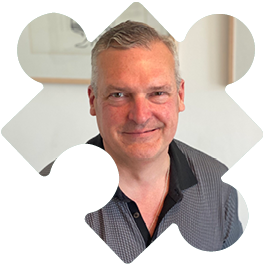Teamwork Rework
Tasked with a years-long business project, an alumnus and his partner crack the code to genuinely leading, innovating, and energizing workplace teams
Do you love your job?
 Edward J. van Luinen
Edward J. van Luinen
While it might be hard for you to imagine, your answer—and that of everyone you work with—can be an unqualified yes, according to alumnus Edward J. van Luinen (EdD ’16). Van Luinen and his business partner, Tricia Cerrone, have joined together to establish Authentic Collaboration, a consulting business grounded in their program of the same name, which promotes a human-centered way of working that enhances workers’ commitment, encourages creativity, and generates trust.
Oddly enough, the program’s creation grew out of a completely different effort. Assigned to jointly manage a company-wide institutional knowledge transfer project as executives at Walt Disney Imagineering in 2013, the duo initiated meetings with groups across the organization. They were determined to do a thorough job, which required the complete engagement of a great many employees.
To ensure they attained that commitment, Van Luinen and Cerrone began with themselves,
agreeing to consciously manage the project as co-collaborative leaders with the same
priorities. “We both put the business first, followed by caring for the company’s
teams and other leaders, and then finally ourselves,” says Van Luinen. That devotion
to their purpose, and the duo’s enthusiasm for others’ involvement in the project,
was contagious. “A team of two at the beginning grew to a team of 70 by the end,”
he adds.
As their three-year project wrapped up, the co-leaders discovered that they’d designed
a truly exceptional approach to working together. Not only did their 70-person crew
avoid turnover, but the passion of the projects’ members inspired many other Imagineers
who sought to work on the team. Van Luinen and Cerrone saw that team members continued
their conversations with their new partners—and with others throughout the company—during
and after the project ended, sharing resources and collaborating on problem solving.
And they were delighted to witness how the group’s work impacted the participants
as contributors to the organization. Their increased knowledge and resourcefulness
raised their visibility within the company, and a number of the group’s members were
thereafter recruited by other departmental leaders.
Realizing that their techniques had created a major shift within the business’s teamwork culture, the duo deconstructed their efforts. They called the method Authentic Collaboration and determined it comprised five core behaviors: generosity, resourcefulness, co-creation, preference for action, and gratitude.
Each of these behaviors, as Cerrone points out, are in fact actions. “They’re things that you do,” she says. “Simply thinking you’re generous or grateful is not sufficient.”
For example, being generous at work means sharing ideas, knowledge, and credit. It is listening to others and encouraging them. It is assuming that the intent behind any action is positive. “Assuming a positive intent removes a barrier to solving a problem,” she says.
The coleaders explain that being effectively resourceful asks individuals to look at tasks curiously rather than critically. Participants in an Authentic Collaboration are encouraged to take advantage of all of their skills and resources and not hesitate to reach out to others for help when they need it. Van Luinen and Cerrone add that being resourceful means making a concerted effort to learn something new at every opportunity. When starting their knowledge transfer project at Disney, they asked each person at the first team meeting what they wanted to learn from the project. Doing so clarified to everyone in the room that they could expect to grow professionally during the course of their involvement.
“At times tossing the agenda is an essential, human way to lead.”—Edward van Luinen (EdD ’16)
“Everyone had equal airtime to share what they wanted to learn,” Van Luinen says. From this, other team members realized that they had something they could teach or bring to the effort. “That began to encourage the team’s generosity, resourcefulness, and willingness to co-create.”
Van Luinen and Cerrone posit that co-creation is not just asking those who specialize in different disciplines to discuss their ideas, but establishing an environment where disparate perspectives are being offered all the time. It is regularly building on new ideas and testing them. “We don’t need a formal, monthly brainstorming session,” says Van Luinen. Co-creation, like all the five behaviors, is a “bottom-up” action. All employees partake and contribute and work together to solve problems and launch something new.
While the preference-for-action component underlies all the program’s behaviors, Cerrone
and Van Luinen consider it a behavior in its own right. While they don’t advocate
upending a business’s workflow processes, they do advocate moving forward, which means
fully leaning into change and taking the initiative to try something new. How often
do we wait for the next meeting or the approval of someone senior to us before taking
our next step? How often do we adhere to what is written in our calendar rather than
address a community need?
During the course of their work at Walt Disney Imagineering, the importance of recognizing
their coworkers’ simple humanity would occasionally take precedence over the business
at hand. Such an instance followed the 2016 Pulse nightclub mass shooting in Orlando.
The tragedy, and the anguish being experienced by the team members, created an emotionally
fragile environment among the Imagineers and naturally became the focus of the day’s
discussion. “Prioritizing each other is at the core of Authentic Collaboration,” says
Van Luinen. “At times tossing the agenda is an essential, human way to lead.”
 Tricia Cerrone
Tricia Cerrone
One way prioritizing one’s coworkers may be demonstrated is by actively expressing one’s gratitude for team members’ contributions—the final component of Authentic Collaboration interactions. The program’s creators strongly support saying thank you often, sincerely, and thoughtfully. After any team event, a leader might walk out with a team member and let them know how impactful their participation in the meeting or event was. “This simple action furthers inspiration, commitment, and engagement,” says Van Luinen. At the close of a project, a leader might share with the team something exceptional that each person did, and how it affected the effort. “To get recognition in front of their peers helps people feel seen, heard, and valued for their unique abilities,” Cerrone notes. “It is a basic human need and one of the main reasons our Authentic Collaboration team expanded.”
Van Luinen and Cerrone found that as their knowledge transfer project took shape at Disney, project participants became their champions at the organization and team members expressed interest in applying it to their own projects. Over time, the coleaders saw that Authentic Collaboration’s core behaviors provided a new way to work and lead that helped solve business goals like onboarding, career mobility, coaching, and knowledge and skill transfer.
“The leaders who thought to spread the message of Authentic Collaboration throughout the rest of the company clearly expressed the values of generosity and resourcefulness that are at the core of the program,” says Van Luinen. “We were like bees pollinating different departments.”
Now sharing Authentic Collaboration techniques in their own business, Van Luinen and Cerrone are eagerly teaching business leaders practical skills to create more united, more collaborative teams. Having witnessed people around them become more energized about their work, they’re confident that employing the five behaviors increases employee happiness and growth while it mitigates employee turnover.
“What we want,” Van Luinen and Cerrone say, “is for people to say, ‘Hey, I love my job.’”
